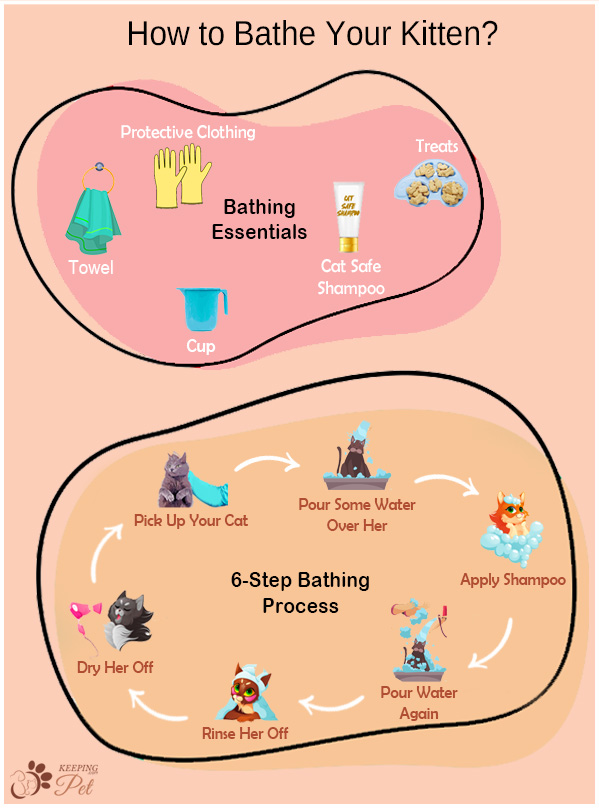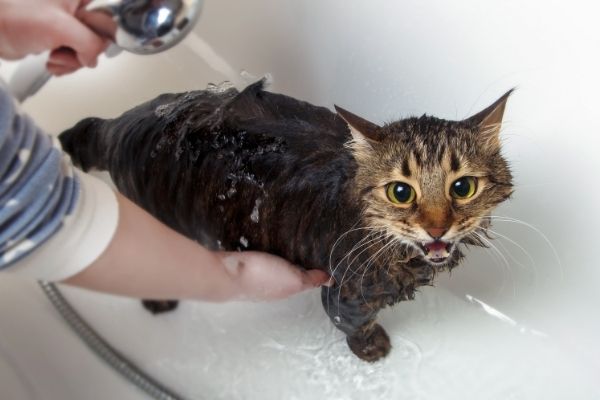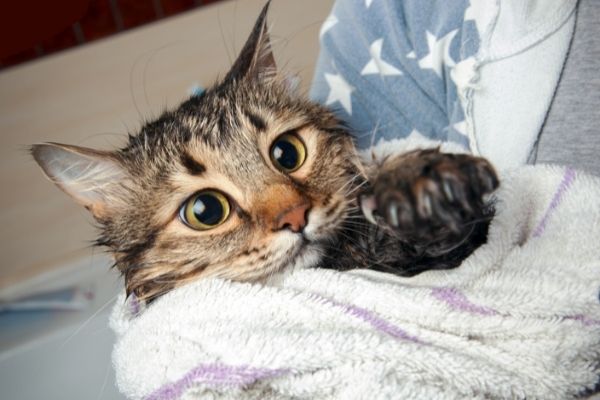The self-grooming skills of a kitten are not as developed as those of an adult cat. These baby felines are more likely to get their face dirty while eating or mess up their litter box and may require a little help from you to clean themselves. Since most cats are afraid of water, you might wonder how to bathe a kitten without getting yourself scratched.
Bathing your kitten can sometimes become necessary if it has stepped onto something smelly, dirty, and unclean or if it has picked up some parasite from your lawn. Moreover, keeping a kitten clean is necessary for its overall well-being as dirt and bacteria can cause skin diseases and infections like pyoderma.
Here is a quick guide on how to bathe a kitten and enjoy the whole process in 7 simple ways. But before we move on to the bathing part, let’s discuss the pre-bath part briefly.
Before the Bath
Here are a few things you need to be aware of before giving your kitten her first bath.
1. The Right Time for Your Kitten to Have a Bath?
The fact is that most kittens don’t need to bathe daily since they are masters at self-cleaning and grooming. However, if you recognize that your cat has fleas or has stepped onto something dirty and oily, it’s time for your kitten to have a bath.
However, it also depends on the age of the cat. According to research by Animal Compassion Network, your kitten needs to be at least 8 weeks old to be ready for the bath. Avoid bathing her in this period and wait unless she turns 8 weeks.
2. Trimming the Nails
Kittens will protest a bit during their first bathing session, and you don’t want yourself to be scratched by your favorite furry creature. To be on the safe side, it is highly advisable to trim her nails a few hours before her first bath—and keep doing it every time she needs a bath. Many cats get cranky after their nails are trimmed, and you want to bath them in a calm frame of mind.
Besides minimizing the chances of getting scratched, trimming cat nails is an essential part of their grooming requirements. Not sure how to properly cut your cat nails? Here is a 7-step guide on how to trim your cat’s nails.
3. Brush Her Fur Before Soaking Her in Water
You want to make sure that your kitten is free from knots. To do this, get their fur brushed and free those knots and tangles. Experts recommend not skipping this step as those knots and tangles could get even more entangled, offering fleas and other parasites a breeding ground.
4. Protective Clothing
Kittens scratch—and even the younger ones do. To protect yourself, it is advisable to wear a full sleeves shirt of a decent thickness. A long shirt can save you from having scratches all over your arms. It is always better to be safe than sorry.
5. Keep the Bathing Essentials Ready
Before bringing your kitten near the sink (or bathtub), keep the kitten bathing essentials ready. You will need:
- Towel—since cats hate water, you will have to dry her off as soon as the bathing process ends.
- Cup—this is to pour water over your kitten. You can bathe your kitten without a cup as well.
- Kitten-Safe Shampoo—kittens need specially formulated cat shampoos. Don’t bathe your kitten with soap or general shampoo. Do so, and you may seriously damage the skin of your kitten. A shampoo tailor-made to suit your kitten is the best pick in this scenario. And no, you cannot even use even dog shampoo on cats, as the composition of both types of shampoos differs.
- Treats—keep a few cat treats ready. If she gets anxious or resists water, you can distract her by giving her ready beside you.
How to Bathe Your Kitten in 7 Simples Steps

After having all the supplies ready, you can also ask a friend or family member to assist you in the whole process—if he or she is available. Now the process begins!
1. Selecting a Sink or Basin

One of the most common places for a kitten to bathe is a sink or basin. This smaller enclosure provides control over your kitten and makes it easier to cleanse her. Don’t fill the basin with water and put your cat into it. Rather, first put your kitten in the basin and then slowly pour lukewarm water onto it.
If you find the floor too slippery for your cat, try placing a rubber mat to help your kitten from slipping onto the ground.
2. Keep Your Kitten Calm
Your kitten will repeatedly attempt to move out of the sink or avoid the bathtub. Put her gently back into the sink. You might also want to hold her from the back of her neck (scruff) and use the shampoo from your other hand. If she feels uncomfortable with being picked from the scruff, put your hand beneath her. Don’t freak yourself out during the whole process, or your cat will sense it, and be more likely to get worried too.
Rather, take the panic out through your voice and make sure that your cat feels calm and composed. In addition to your calming words, offer her some treats as well. When she is distracted, apply shampoo or pour water on her.
3. Pour Some Lukewarm Water
Once the kitten is calm, pour some lukewarm water until the cat is entirely wet. You can also stroke her fur while pouring water to make her feel calm. You can also get assistance from another person in this process by making one person hold through her shoulders while the other pours water onto her. Avoid pouring water at her face at this stage and pour one cup at a time.
4. Use a Small Amount of Shampoo
At this stage, the kitten is thoroughly wet. Put some shampoo on the back of your cat and start rubbing the fluid onto her shoulders. Now, gently work through her legs, tail, ears, neck, and of course, the tummy. Wash her off and repeat the process. Treat your kitten like a baby and avoid stroking its fur too hard.
Keep reassuring your kitten and stay calm too. Try to keep soap out from his eyes as you don’t want to hurt this little fluffy creature.
5. Rinse Her Off With Lukewarm Water
Now that your kitten is completely soaked in shampoo, use some lukewarm water to rinse her off. Keep pouring water from one hand and use your other hand to wash her fur until the water runs clear. Keep doing it until she is completely shampoo-free and the water is all clear. You can also use a wet washcloth and run it all over her body.
6. Washing Your Kitty’s Face
Kittens generally don’t need their face to be washed with shampoo. A small amount of water would suffice the job and keep her fresh. Take a wet washcloth and gently rub it over her face. Never put the face directly in the water, or it will make her seriously uncomfortable.
7. Drying Your Kitten

You can dry your kitten by wrapping her in a towel. But before using a towel, gently rub your fingers onto her body to make her feel a bit more relaxed. Once you are done with that, you can use a towel to dry her. You might have seen some people using hair dryers on their kittens. You can also use one by setting the heat to the lowest level and gently drying the fur. But remember that some cats are terrified of dryers, so know what works best for your cat.
Once you think the job has been completed, you can reward your little one with hugs and cuddles. The initial experience of the bath may have made your kitten a little upset. But through gentle care, you can associate the bath with good things instead of bad so that she is more likely to go for a bath readily than avoid it.
So, how to bathe your kitten in a safer way?
To summarize, keep the bathing essentials—towel, kitten-safe shampoo, cup, and treats—ready. Gently rub her, keep the water lukewarm and bring her close to the sink. Pick her up from the back of their shoulders, pour some water over her, apply shampoo, and rinse her off. When the dirt leaves, pour some water again—keep the water pouring until the water turns clear. Once that is done, it is time to dry her off in a towel.
